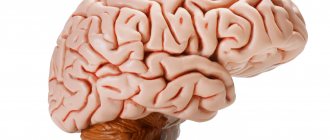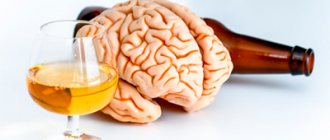Is the brain not a place for memory?
Representatives of neuroscience have been busy localizing various cognitive processes for many years: they are looking for specific parts of the human brain responsible for certain higher mental functions.
If reports are to be believed, scientists have already discovered areas associated with appetite, fear, excitement and even the ability to recognize lies, not to mention the perception of one's own personality. But the place where our memory could be “stored” has not yet been found. “The first person to discover this zone will probably be awarded not only the Nobel Prize, but will also be included in the cohort of the most outstanding scientists,” says Soviet and Russian biologist, specialist in the field of cellular mechanisms of memory and learning Pavel Balaban.
Memory is believed to consist of:
- sensory register, where information from the senses is received: visual - into iconic memory (where ~ 0.5 seconds is stored), auditory - into echoic (3-8 seconds);
- working - short-term - memory (~ 18–30 seconds);
- long-term memory.
When remembering something, we do not retrieve information from some kind of storage. Memories are created anew every time.
Russian neuroscientist Konstantin Anokhin believes that information “travels,” being formed in some brain structures and “extracted” from others. Whenever we “remember” something, we “forget” it, replacing it with a new one - we can say that the brain “overwrites” memories, although this definition is incorrect, since the memory carrier, we repeat, has not yet been discovered.
American psychiatrist, neuroscientist and professor of biochemistry Eric Kandel compares the brain to a wiring diagram of an unimaginable number of neuronal contact points. Let's take an experimental dog: if you hit it with a light electric shock when turning on the light, the light bulb will come on every time, causing stress, fear and generally unpleasant sensations. If you give meat at every “light signal”, the dog will “forget” fear and “love” the light - the switched on lamp will become a harbinger of joyful events for it. Simply put, this happens because in each case, information about light enters different areas of the brain. In the first - those responsible for defense, in the second - for digestion.
Kandel argues that this is due to prion-like proteins that act as “routers” at the contact points of neurons.
As prions age, they transmit information to new growth - this is the process of so-called protein heredity, which occurs between proteins without the participation of DNA.
This hypothesis is proposed by Kandel as an explanation of the memory mechanism.
Memory abilities
A similar set of functions, responsible for cognitive processes, storage and reproduction of data, exists in all animals with a developed central nervous system. This ability has achieved the greatest progress in humans.
- There are two known stages of adding information to the biological data store: short-term and long-term memory.
- The first one is easy to destroy with anesthesia, electric shock and other influences - in any case, it “lives” no longer than a few tens of minutes.
- Long-term memory ideally lasts throughout a person's life. It is quite resistant to the influences described above.
- When moving from one type of memorization to another, certain chemical processes are activated. Even unusual memory works with the help of special substances - neurotransmitters that communicate between neurons.
- There is also a third memory mechanism. However, it works at the level of instincts. Sensory memory receives information from the senses. Closing his eyes, a person sees the silhouette of what was in front of him a second ago. This is this type of memorization. It is short-lived and quickly replaced by new data.
- Some experts add collective and external memory to this list. The first one stores the totality of human knowledge, and the second one contains books, computers and other ways to store information outside the brain.
Is a complete mapping of our brain impossible?
The project of mapping all the connection points of neurons is called connectome. So far, we have only been able to describe the connectome of a nematode worm measuring about 1 mm, whose nervous system consists of just over 300 neurons.
As for describing the connectome of the human brain, which contains ~86 billion nerve cells, there is still no general idea of the scale of this project.
What is clear is that it is much more complex than deciphering the human genome or even the proteome (a set of proteins).
Scientists, for example, are attempting to describe the rat brain in this way. “We mapped an area the size of a match head - it took terabytes of memory. And it’s not clear what to do with such a volume of information,” says Russian anthropologist and popularizer of science Stanislav Drobyshevsky. He emphasizes that the problem is that we are trying to comprehend the results of these studies “with the same brain, which no longer accommodates information about itself - it turns out to be a vicious circle.” To understand how our brains work, we need a “bigger brain than ours.”
What is memory? And what types of it do you have?
Memory can be described as the process of storing information over time. Or as the ability to use past experiences to determine our future path.
When people are asked to define memory, most give the example of simply remembering information for a test or information about where the car keys are. However, memory is important in our daily life. We cannot function in the present or move forward without relying on it.
How we form memories
Memory loss
is often associated with aging, but there are a number of things that can cause short-term and long-term memory loss, including injury, medications, or a traumatic event.
Memory types
Although experts have different definitions of short-term memory, it generally refers to the recollection of things that happened over a period of several days. It is generally believed that between five and nine items can be stored in active short-term memory and can be easily retrieved. Patients suffering from short-term memory loss cannot remember who entered the room five minutes ago, but they perfectly remember their friend whom they have not seen for 50 years.
Implicit memory
sometimes referred to as
unconscious
or
automatic
memory. Implicit memory uses past experiences to remember things without thinking about them. For example, musicians or athletes cope more successfully with tasks for which they were prepared in advance.
◾ Ice skating.
◾ Climbing stairs.
Semantic memory
not related to personal experience. Semantic memory includes things that are common knowledge, such as country names, letter sounds, country capitals, and other basic facts. Some examples of semantic memory:
◾ Knowing that the sky is blue.
◾ Knowledge of how to use cutlery.
◾ Knowledge of what a dog is.
◾ Knowledge that Victory Day is May 9.
◾ Where were you and with whom, at the moment when you found out that you had a child.
◾ Your holiday at the resort last summer.
◾ Your first time flying on an airplane.
◾ Your first working day at a new job.
◾ The restaurant where you met your partner.
It is not entirely clear why some memories of events in our lives are stored in memory while others are not recorded. Scientists believe that emotions
play an important role
in what we remember.
Source
Are all people cyborgs?
Philosopher and scientist Andy Clarke believes that the human mind is always more than what “happens inside an ancient fortress of skin and skull.”
Clark blurs the boundaries between the "inner mind" and the "outer world" and argues that the human mind has always been externalized - extended outward.
The mind, according to Clark, is what is scattered in the things around us, external means of storing and retaining information, be it a paper notebook, a road sign, a store sign or a computer.
In this sense, we are all - no less than - cyborgs. And they always have been.
Clark rejects the idea of a separate “I”, but considers it promising not only to “expand outward”, but also inward, since “consciousness is <...> a huge, quiet cave of underground mental mechanisms, with its pipes, synapses and electrical impulses that form a pulsating substrate of the self. <…> When you think about all these fundamental mechanisms - ancient and shared with other mammals and distant ancestors <...> consciousness can seem like just a surface phenomenon, a user interface obscuring the real workings at lower levels.”
Is attention a fiction?
The first theoretical model of attention, the filter theory, was created by the English experimental psychologist Donald Broadbent.
According to this theory, the nervous system carries out selection by working as a single communication channel (with multiple inputs). The choice of this or that information may depend on the state of the body, external physical conditions (sound volume, for example) or psychological attitudes (the mood to accept this or that information). The filter blocks the remaining channels, but “the unclaimed one is stored for some time in a short-term storage unit, and then can pass through the communication channel - if there is a shift in the selective process from one class of sensory events to another.”
This model was later expanded by attention psychology researcher Anne Trisman. According to her findings, the entire flow of information comes through many parallel channels. The filter “passes” some signals, and attenuates others. Both the first and second pass through a “logical analyzer”, operating on the basis of a conditional “individual’s dictionary”.
And the Danish psychologist, philosopher and teacher Edgar Rubin, in his report with the telling title “The Non-Existence of Attention,” made more radical conclusions:
“The term “attention” does not mean anything definite and concrete <...> to put it in correspondence with a certain reality.
When, for example, a certain Mayer looks at his notebook, it can be pseudoscientifically expressed as follows: “Mayer directed his attention to the notebook.”
Apparently, they say this not only for the sake of sophistication of expression, but also in order to open the way to the dangerous misunderstanding that in our cognitive life there is a kind of spotlight that moves here and there over the perceived object.
Brief lecture notes
Unfortunately, Polina Krivykh, when requesting the rights to use the material for a blog article, recommended excluding the reproduction of even a single synchronization lecture slide, but kindly allowed the use of materials from her personal website. Thus, an interesting task arose for me just from the area of memory - how to remind myself as much as possible about the lecture material without using lecture slides? That's right, with written notes and visuals.
Remember everything: the psychology of memory
The lecture is given by: Polina Krivykh.
What will we talk about?
- How do scientists define memory?
- Memory classification
- Physiology of memory
- Types of amnesia and Korsakov's syndrome
- Implantation of memories
- Clinical tests to test memory
- Ebbinghaus curve
Terminology classification
Memory is the ability to store, consolidate, reproduce and forget information.
Memory is classified according to the duration of information storage.
- Ultra-short-term - up to 0.2 seconds
- Short-term memory - up to several hours
- Long-term memory
Previously, based on Miller’s research, the number 7 (+-2) was identified as the volume of short-term memory in units. The unit can be any memorization object. This can be clearly illustrated by the example of how a person remembers a telephone number.
When memorizing a phone number, a person mentally groups the numbers into the units given above. For example, a ten-digit cellular number in Russia, we usually remember as the country code (the first unit, it’s easy to remember because the code for all Russian numbers is one, +7), the operator code (the second unit, for example Beeline, 903), then Depending on convenience, we group the number into numbers of 2-3 digits. The total is 4-5 units.
However, later, based on additional experiments, scientists obtained a number of 4 (+-1) units, since they took a wider range of subjects, unlike Miller, who conducted experiments with Harvard and MIT students, who a priori gave higher results because . the subjects were engaged in intellectual work and their memory was more developed.
The process of transferring information from short-term to long-term memory is called consolidation.
The storage period of information in long-term memory is almost unlimited. Speaking about the specifics of long-term memory, it is necessary to take into account that it works like a library without a clear hierarchical model and addressing access to areas, so we do not forget anything, but we may lose access to stored knowledge. This determines the phenomenon that information can be forgotten and then recalled after a while.
Memory is also classified by selectivity of memory (performance).
- Involuntary memory is the ability to remember information without a purpose, for example, remembering the names of characters in a TV series, words of a song, etc.
- Voluntary memory is the ability to purposefully remember information. For example, telephone numbers, lectures, addresses, etc.
Involuntary memory works without a targeted stimulus and works better than voluntary memory. Currently, many methods of teaching children are based on involuntary memory. Emotional coloring of information also contributes to better memorization.
Iconic and echoic memory (modality)
In fact, this is visual and auditory memory, which in ultra-short-term memory stores different amounts of time (iconic - 0.3 s, echoic - 2 s) necessary for processing and assimilation of information. For this reason, audiobooks are absorbed and perceived quite well. But this does not mean at all that printed books are absorbed worse - they are quite effective, including because most people verbalize what they read, and also work more actively with their imagination.
Declarative and procedural memory (content)
Procedural memory is actually everything we learn to do (ride a bike, skate, etc.). Procedural memory provides reliable long-term storage, forcing us to virtually always use previously learned skills.
Declarative - episodic memory. All the memories of my life. It can be divided into two subtypes: autobiographical (memory of facts about oneself) and semantic memory (memory of facts).
Interim conclusions
- Memory is the ability to store, process and reproduce information.
- The three-component model of memory distinguishes ultra-short-term, short-term and long-term memory.
- In terms of performance, memory can be either voluntary or involuntary.
- According to modality, memory is divided into echoic and iconic.
- According to content, memory is divided into declarative and procedural.
Physiology of memory
The hippocampus (from ancient Greek ἱππόκαμπος - seahorse) is part of the limbic system of the brain (olfactory brain). Participates in the mechanisms of emotion formation, memory consolidation (that is, the transition of short-term memory to long-term memory).
What's interesting is not that the hippocampus is responsible for consolidating memories, but that it can change in size throughout life. Both decrease and increase.
London taxi drivers who did not use a GPS during their trips had better memory development and an enlarged anterior hippocampus. However, it was also found that the hippocampus shrunk in those who started using GPS or quit their jobs. In other words, the hippocampus, with its properties, resembles a muscle that can be pumped up with training, and which atrophies without training. With intense exercise, new nerve cells can appear in the hippocampus.
Patient HM Science knows of only one case in which a patient had his hippocampus removed. This operation was performed in 1953, at the request of the patient HM (Henry Gustav Molaison), since it was established that the causes of the patient’s epileptic seizures were localized there.
As a result of the operation, it was possible to save the patient from epileptic seizures, however, as a result of the operation, the patient lost the ability to remember. As a result, he clearly remembered everything that happened to him before the operation and completely lost the ability to remember everything that happened after. It’s amazing that all his life he clearly remembered that he was 20 years old and remembered how he agreed to the operation. As a result of this case, it was possible to establish for certain that the hippocampus is responsible for memory consolidation. The hippocampus can and should be developed.
Neuron structure
At the lecture, the structure of a neuron and the principles of forming connections between neurons were superficially analyzed. If desired, I would recommend consulting the Wikipedia article on neurons. For myself, I only learned that there are about 90-95 billion neurons in the human brain and that neurons can connect one to another, forming biological neural networks that ensure the functioning of the brain. I think that it will not be a revelation to anyone that alcohol interferes with memory and there is even a term for alcoholic amnesia. Stress amnesia also occurs, when the memory mechanism is turned off as a result of a stressful situation. For example, those who survived a terrorist attack may remember everything that happened before, but not what happened during. A huge surge of adrenaline blocks the appearance of a protein necessary for the formation of neural connections.
Interim conclusions
- Memories are not instantly recorded in long-term memory
- The hippocampus is responsible for the consolidation of memories, i.e. their transition from short-term memory to long-term memory.
- We learned about the role of the hippocampus in memory consolidation thanks to patient HM
- The delta-fosBeta protein is responsible for the proliferation of the spiny apparatus, which improves memory.
- There is a concept of alcoholic amnesia.
Memory impairment and memory implantation
There are many types of memory impairment, the main one being amnesia. By the way, every healthy person has infantile amnesia - a person does not remember everything that happened to him before the age of 3-4 years. This is associated with the underdevelopment of the human brain at an early age.
There are 10 or more types of memory disorders, the most popular of which are:
- retrograde amnesia (a person does not remember the past),
- anterograde amnesia (a person cannot remember everything that happened to him after an injury),
- anterograde amnesia (a combination of retrograde and anterograde types of amnesia),
- Korsakov syndrome (a person loses his memory in fragments, despite the fact that he can remember the past well, characterized by disorientation in space in an unfamiliar area, false memories),
- dissociative fugue (a person forgets everything he knew about himself, takes a new name, then after a while he can suddenly remember everything that happened to him before the fugue and forget everything that happened during)
S.V. Shereshevsky
Shereshevsky is the owner of a phenomenal memory, a mnemonist who worked for 20 years with psychiatrist A.R. Luria. Throughout this time, it was never possible to establish the limits of Shereshevsky’s memory in terms of duration and volume. Shereshevsky told Luria about the method of mnemonic memorization techniques, for example, placing things on an imaginary path and then walking along this path to remember these things. He also used flying techniques to forget unnecessary information. Alexander Luria described the life of Shereshevsky in the book “A Little Book of Great Memory” (1968).
Implantation of memories E. Loftus
In the United States, after the psychology boom of the 1970s, many grown children sued their parents for mistreating them as children. With the help of Elizabeth Loftus, in a number of cases it was proven that people had substitute memories implanted in them by the incorrect work of psychologists. A periodically asked question: “Are you sure your parents did not commit any violence against you?” – could lead to the emergence of a substitute memory.
The simplest test showing how substitution memories work - the test subjects were asked the question - “Did you see Bucks Bunny at Disneyland?” Some subjects responded positively to this question, although the Warner Bros. character Bucks Bunny was never introduced at Disneyland.
Elizabeth Loftus has developed a technique for testing a memory to determine whether it is one's own or implanted. Essentially, if you see yourself in a memory, then it is most likely an implanted memory: you either saw a photo or perceived a story about you.
An implanted memory is indistinguishable from the point of view of the encephalogram. For the brain, everything that is already stored in memory is absolutely real. Whether a memory is false or not is no longer possible to distinguish from the point of view of brain research, however, it is possible to establish this with the help of psychotherapy. Elizabeth Loftus has appeared in court hundreds of times as a forensic scientist and helped identify false memories.
Interim conclusions
- The following memory disorders can be distinguished: amnesia, Korsakov's syndrome, hypermnesia, implantation of memories.
- Amnesia is divided into organic (retrograde, anterograde and anteroretrograde) and functional (epileptic, post-hypnotic, infantile).
- Korsakov's syndrome is a special complex of memory disorders.
- Elizabeth Loftus has been researching memory implantation.
- The most famous Loftus experiments: with the speed of cars, Bugs Bunny Effect, Lost in the mall.
Memory testing
Bluma Vulfovna Zeigarnik
Completed actions are remembered 1.9 times worse than uncompleted ones. However, people with chronic stress have equal difficulty remembering completed and unfinished activities. I noticed that when I publish an article, I almost immediately forget its details (this is the Zeigarnik Effect).
The Zeigarnik effect (better memorization of an unfinished action) is also used to solve or overcome a block in a particular task. This is because the brain continues to solve the problem in the background.
Ebbinghaus curve
The curve shows the relationship between the number of repetitions and the retention of information. When repeating information daily on the 4th day, 90% memorization is achieved.
Interim conclusions
- To assess memory, a variety of techniques are used: the Leontiev technique (cards), the pictogram method, and the Zeigarnik effect is measured.
- The Zeigarnik effect can be used to improve problem solving efficiency
- The Ebbinghaus Curve reflects how much information we forget without repetition.
- Due to interference mechanisms, when memorizing a list of words, we experience edge effects: we remember the first and last words better.
- Jost's Law: Distributed learning is more effective than concentrated learning.
Summing up
- Memory is the ability to store, process and reproduce information.
- There are many different classifications of memory.
- The hippocampus plays an important role in the formation of memories.
- A variety of techniques are used to assess memory.
- The Ebbinghaus Forgetting Curve reflects how much we forget.
List of recommended literature
- A.R. Luria “Little book about big memory”
- Joshua Foer “Einstein Walks on the Moon”
- Rita Carter “How the Brain Works”
- Yu.B. Gippenreiter “Introduction to General Psychology”
- Elizabeth Loftus at the TED conference “How reliable is your memory?”
- Maria Falikman, course of lectures on the PostScience resource
At the end of the lecture, the audience was recommended to watch a film, which, according to experts, explains quite well how memory works. I immediately watched the film “Eternal Sunshine of the Spotless Mind” (2003), it deserves a separate article. I even watched it twice in a row, the film is amazing, it influenced me very much, I felt a response, this story seemed quite personal.
As for another striking film about the memory device, I would recommend watching the film Remember (Memento - 2001), although nothing was said about it during the lecture, it creates a stunningly accurate feeling of a person who has lost his memory.









